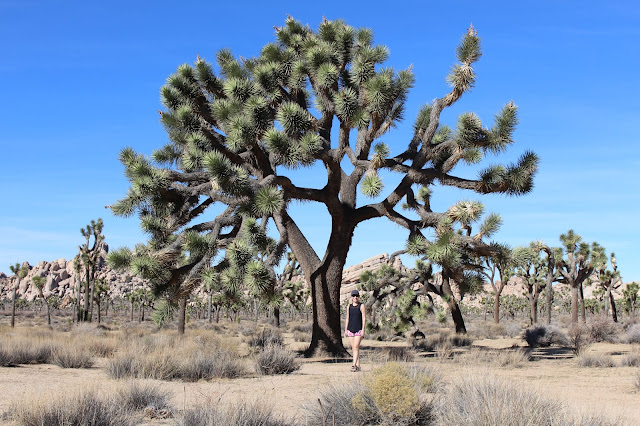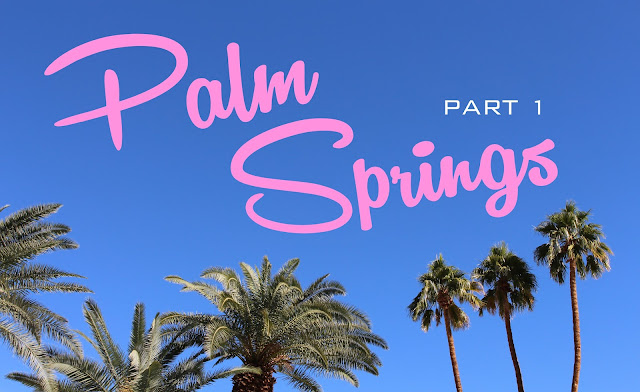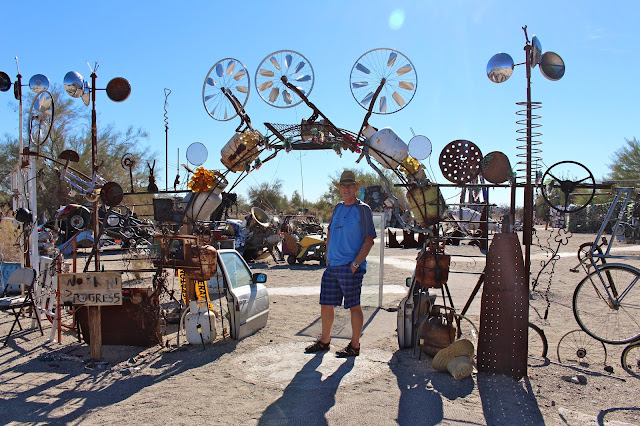A star-studded oasis in the Mojave ever since the heyday of Frank Sinatra’s Rat Pack, ‘PS’ is a retro-chic getaway for LA urbanites. We’re here for ten days to do like A-list stars and hipsters do: lounge by a mid-century modern hotel’s swimming pool, go art gallery hopping and vintage shopping, then drink cocktails after sunset.
The hot colours of a desert blooming with wildflowers animate The Saguaro Hotel where we’re staying. It offers uncomplicated fun with a splash of mid-century technicolour. The view from our room is hard to beat.

Sandi knows just where she wants to go after check-in and she knows just what she wants—the hotel’s popular bar, El Jefe, for a watermelon margarita.
This morning we’re driving to Salvation Mountain but first caffeine at Koffi (the perfect antidote to watermelon margaritas). This cool, minimalist, indie java bar serves strong, organic coffee and an addictive latté.

Southeast of the Salton Sea, Salvation Mountain is a mighty strange sight indeed: a 100ft-high hill of concrete and hand-mixed adobe slathered in colourful paint and found objects (hay bales, tires, telephone poles) and inscribed with religious messages, surrounded by chapel-like grottoes.
Love doesn’t have to be complicated. Keep it simple.
The work of Leonard Knight (1931-2014) was 28 years in the making and has become one of the great works of American folk art that’s even been recognized as a national treasure in the US Senate. It’s in Niland, about three miles off Hwy 111.
We hop back in the car and swing through Slab City, down the road just past Salvation Mountain. It’s one of the only places in America where you can truly live off the grid.
The area is mostly inhabited by snowbirds and other desert animals during the winter months. There is no electricity, running water, sewer or toilets. It is a refuge for artists and musicians looking to create without boundaries and with minimal expenses.

Taking a page from a Dr. Seuss book, the whimsical Joshua trees (actually tree-sized yuccas) at Joshua Tree National Park welcome visitors at the convergence of the Colorado and Mojave Deserts. It was Mormon settlers who named the trees because the branches stretching up toward heaven reminded them of the Biblical figure Joshua pointing the way to the promised land.
Rock climbers know ‘JT’ as the best place to climb in California but kids and the young at heart also welcome the chance to scramble up, down and around the giant boulders.

Hikers seek out hidden, shady desert-fan-palm oases fed by natural springs and small streams, while mountain bikers are hypnotized by the desert vistas.
We’re hiking the Hidden Valley Trail and the Keys View Trail.
The breathtaking views at Keys View (5185ft) take in the entire Coachella Valley and extend as far as the Salton Sea and, on a good day, Mexico. Looming in front of us are Mt. San Jacinto (10,834ft) and Mt. San Gorgonio (11,500ft), two of Southern California’s highest peaks, while down below we spot a section of the San Andreas fault.
The mystical quality of this stark, boulder-strewn landscape has inspired many artists, most famously the band U2, who named their 1987 album The Joshua Tree.
These petroglyphs in a cave were “enhanced” with paint, sometime between 1950 and 1970. Some speculate it was by Disney for the 1961 television movie Chico the Misunderstood Coyote.
Skull Rock is a favourite photo opportunity for park visitors.
To see the natural transition from the high Mojave Desert to the low Colorado Desert we wind down to Cottonwood Spring, a 30-mile drive from Hidden Valley and stop at the Cholla Cactus Garden where a .25-mile loop leads around waving ocotillo plants and jumping ‘teddy bear’ cholla.

The best way to end a dusty day is a soak in the hot tub back at The Saguaro.








































No comments:
Post a Comment